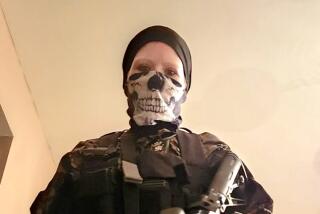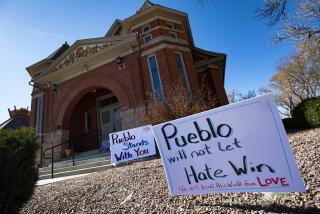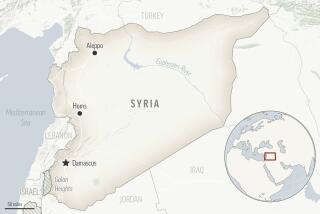Resilient Al Qaeda Resumes Plotting
WASHINGTON — For months, U.S. officials have boasted of knocking out Al Qaeda’s command center in Afghanistan and said they were well on their way to dismantling Osama bin Laden’s worldwide terrorist network.
The Al Qaeda leadership was forced to go on the run, officials said, its soldiers hard-pressed to launch new attacks. And while authorities repeatedly sounded warnings, they were the first to acknowledge they had little, if anything, to go on.
But recently, U.S. officials have received unsettling--and specific--indications that Al Qaeda has again become a deadly organization with an intact leadership, a global reach.
That troubling assessment is based on far more than the arrest of Jose Padilla, also known as Abdullah al Muhajir, a U.S. citizen who allegedly plotted with senior Al Qaeda leaders to detonate a “dirty” bomb somewhere in the United States, authorities said.
It is based on recently gleaned intelligence information, they said, including evidence that Al Qaeda has reconstituted a command structure and found a safe haven for it somewhere in the vast badlands of northwest Pakistan. Bin Laden, his deputy Ayman Al-Zawahiri and several other top commanders are all believed to be alive and hiding somewhere in Pakistan or Afghanistan; other operatives such as Khalid Shaikh Mohammed are suspected of having joined the group’s top echelon, authorities said.
At least parts of that command structure are now slipping into and out of Afghanistan despite the U.S. presence there, meeting with Al Qaeda operatives and planning more attacks, officials said in interviews. The Al Qaeda leadership is also reaching out to potentially thousands of “sleeper” agents all over the world trained in terrorist camps in a variety of urban warfare techniques, officials said.
“The leadership may be on the run, but they’re certainly not out of commission,” said one Bush administration official, adding that although the intelligence information is “hard,” authorities haven’t found the specific location of the new Al Qaeda base of operations.
Nevertheless, the official said, “The intelligence community believes that ... they are still meeting and that there are sanctuaries around the world that are providing them with support. Think of all the Al Qaeda leaders still at large--it could be any of them” leading the regrouping effort.
“You can assume, and you should assume, that any number of plots are still active,” added the official, who spoke on the condition of anonymity. “Who is to say that all the chatter last summer on the intelligence channels was just about 9/11?.... I can guarantee you that there are other plots out there.”
On Sunday, in fact, an Al Qaeda spokesman issued a public declaration, warning Americans to get ready for another attack on the scale of Sept. 11, or worse.
“What is coming to the Americans will not, by the will of God, be less than what has come,” said Sulaiman Abu Ghaith in a posting on the Al Qaeda-affiliated Al-Neda Web site. “So beware, America. Get ready. Get prepared. Put on the safety belt.”
Perhaps most troubling, Al Qaeda now appears to be working with U.S. citizens and other operatives with backgrounds that make it particularly easy for them to compromise U.S. border security, even as the United States spends billions to catch suspect foreigners in a counter-terrorism safety net.
U.S. officials also confirmed that until several weeks before his arrest, they had never even heard of Padilla, even though his mission appeared to be well underway. Padilla took the Muslim name Al Muhajir after a stint in a Florida jail. Padilla, born in New York City, lived in Chicago and then Florida until about three years ago, when he began traveling in the Middle East, Afghanistan and Pakistan, authorities said.
Deputy Defense Secretary Paul D. Wolfowitz said Monday that Padilla met with “senior Al Qaeda members” this year to discuss plans to detonate a radioactive dispersal device.
FBI Director Robert S. Mueller III described those conversations as “substantial.” Authorities also confirmed that one of the Al Qaeda participants was top Bin Laden lieutenant Abu Zubeida, who spoke with Padilla in the weeks before his capture March 28 in Faisalabad, Pakistan.
Padilla, according to Wolfowitz, had researched nuclear weapons and received training in wiring explosives while in Pakistan, before being instructed to return to the United States to conduct reconnaissance operations for Al Qaeda.
Authorities said the plot had not yet advanced past the discussion stage, but that they had substantial intelligence to indicate that it was real and being taken very seriously by the Al Qaeda leadership. At a news briefing, they would not discuss whether they have identified any co-conspirators in the United States or elsewhere.
The arrest provides a blend of reassuring and disquieting news for a nation roiled by frequent alarms about terrorism risks.
At one level, it shows the beefed-up U.S. counter-terrorism operation foiling a potential plot before it could go very far--a notable triumph.
On the other hand, it shows how much U.S. counter-terrorism officials still don’t know. A senior U.S. intelligence official said Padilla was under surveillance for several weeks before his arrest on May 8.
“It shows again how we weren’t doing the work on Al Qaeda that we should have done,” said Kenneth Katzman, a terrorism expert at the Congressional Research Service.
Bruce Hoffman, a terrorism specialist at the Rand Corp., said Al Qaeda’s apparent use of an American such as Padilla also is “very worrisome.”
“There’s obvious recognition that the most valuable asset they can deploy against the United States is an American with a clean passport,” Hoffman said.
Within months of the punishing military strikes in Afghanistan in October, Al Qaeda appeared to have resurfaced, at least in part.
U.S. officials believe the terror network helped send British vagabond Richard Reid on his mission to blow up a packed commercial jetliner as it flew from Paris to Miami at Christmas, and perhaps played a role in the abduction and execution of Wall Street Journal reporter Daniel Pearl.
More recently, terrorists suspected of being affiliated with Al Qaeda launched two car bomb attacks, at a synagogue in Tunisia and a tourist hotel in Pakistan, that killed at least 30 people and injured dozens more.
But the new intelligence marks the first concrete indications that Al Qaeda’s top leadership has been involved in plotting post-Sept. 11 terrorist acts in the United States, authorities said.
That intelligence, coupled with the warning from one of Al Qaeda’s own leaders, has U.S. officials more on edge than at any time since the attacks on the World Trade Center and Pentagon, they said.
Ghaith, a Kuwaiti-born cleric and close aide to Bin Laden, is considered an official spokesman for the terrorist network.
On the Al-Neda Web site, which has in the past carried news and statements from Al Qaeda and Taliban leaders, Ghaith said the network would continue to strike Americans and Jews, either as “individuals or institutions,” according to a translation published by the pan-Arab daily newspaper al-Hayat.
“We are still at the beginning of the road. The Americans have not yet suffered from us what we have suffered from them,” said Ghaith, adding that the United States had killed, directly or indirectly, thousands of Muslims in Iraq, Palestinian territories, Afghanistan, Sudan, the Philippines, Bosnia and Kashmir.
“So we have the right to kill 4 million Americans, including 1 million children, displace double that figure and injure and cripple hundreds of thousands,” Ghaith said. “We have the right to fight them by chemical and biological weapons so that they catch the fatal and unusual diseases that Muslims have caught due to their [U.S.] chemical and biological weapons.”
Times staff writer Eric Lichtblau contributed to this report.
More to Read
Sign up for Essential California
The most important California stories and recommendations in your inbox every morning.
You may occasionally receive promotional content from the Los Angeles Times.











